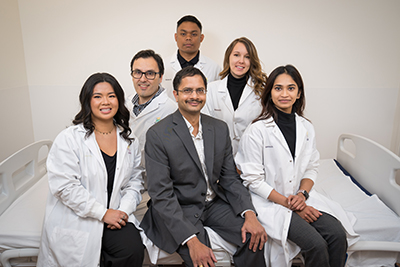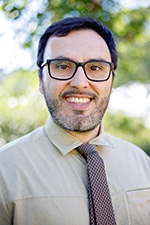Saurabh S. Thosar Lab

About Dr. Thosar
Dr. Thosar received a professional bachelor's degree in occupational therapy from Maharashtra University of Health Science in India and a master's degree in Movement Sciences from the University of Illinois at Chicago. After two years of practicing occupational therapy and cardiac rehabilitation, he returned to get his doctorate and earned a Ph.D. in Human Performance from Indiana University Bloomington in 2014. He pursued postdoctoral training at OHSU in Dr. Shea's laboratory from 2014-18. During this time, his work was supported by a fellowship from the National Space Biomedical Research Institute, an early clinical investigator award from the Medical Research Foundation of Oregon, and a postdoctoral fellowship from the National Institutes of Health.
Dr. Thosar secured a faculty position at OHSU and started his research group in 2018. His group studies the interactions between sleep, circadian rhythms, and physical inactivity/activity related to cardiovascular disease in people with chronic disease.
He is an associate professor at the Oregon Institute of Occupational Health Sciences and holds secondary appointments in the Schools of Nursing, Medicine, and Public Health. His laboratory is currently funded by a five-year NIH R01 grant.
Dr. Thosar is a culturally aware mentor. He is a graduate of the OHSU mentoring academy based on CIMER's (Center for the Improvement of Mentored Experiences in Research) mentoring curriculum designed to address the National Institute of General Medical Sciences' mentoring expectations.
To contact Dr. Thosar for training opportunities, email thosar@ohsu.edu
Laboratory team members

Dr. Brito received a B.S. in Movement Sciences from Paulista University in 2008. Pursuing an academic career, Leandro earned a master’s degree (2011-13) and a Ph.D. (2014-18) in Human Physiology from the University of São Paulo, Brazil, with an internship period in the University Oregon at the Department of Human Physiology. Dr. Brito’s first postdoctoral position (2018-21) was at the University of São Paulo, Brazil, where his work was supported by the São Paulo Research Foundation (FAPESP). He pursued to expand his research skills to circadian biology and the sleep field by joining Dr. Thosar`s laboratory (2022-24). During this time his work was supported by a fellowship of the OHSU Fellowship for Diversity in Research and an early clinical investigator award from the Medical Research Foundation of Oregon.
Dr. Brito’s research focuses on the interrelationship among exercise physiology, circadian biology, and cardiovascular health to propose new chronotherapeutic exercise-based interventions against cardiovascular risk in vulnerable populations.
Dr. Brito is a Research Assistant Professor at the Oregon Institute of Occupational Health Sciences in Dr. Thosar’s laboratory. His work is currently funded by a three-year Career Development Award from the American Heart Association.
Leandro is an active member of the Brazilian Hypertension Society. He served as one of the coordinators of the annual well-faire campaign (2018-22), as the executive director (not-stipendiary) of the Department of Physical Activity (2021-22), and he currently serves as a member of the Young Investigators Board (not-stipendiary) (2023-24).
Nicole Chaudhary, MPH, Senior Research Assistant
Nicole Chaudhary received her Bachelor in Science in Biology, with specialization in Pre-Biomedical Professions from the University of Wisconsin-Whitewater. She also holds a Master’s in Public Health, with focus in Environmental Systems and Human Health from the OHSU-PSU School of Public Health. Before joining the Thosar Lab in 2021, she worked in healthcare for 7 years as a memory care resident assistant and as drug-compounding specialist/ medical assistant for an infectious disease/ travel clinic. In her free time she enjoys dinner parties with her family, travelling along the coast, and gardening.
Alaknanda Melethil, MS, Research Assistant II
Bio: To come shortly
Research interests
Our laboratory’s broad interests are to study the effects of physical inactivity, circadian rhythms, and sleep on cardiometabolic health. We are also interested in studying how common daily behaviors interact (e.g., daytime physical inactivity affecting nighttime sleep).
Current projects include:
Goldilocks Study:
IRB #: 21448; Sleep duration and cardiovascular health
We are investigating how extremes in sleep duration affect cardiovascular health, such as the function/structure of blood vessels, blood biomarkers, and blood pressure. We are also examining the effects of sleep regularization on cardiometabolic health. Results of this study may contribute to a better understanding of how long or short sleep duration is related to cardiovascular risk.
If you are interested in participating, please access our eligibility survey: https://redcap.link/Goldilocks
Or email/ call us at clinphys@ohsu.edu / 503-494-5536
PI: Dr. Saurabh Thosar
Hypertension Study
IRB #: 23776; Sleep and Circadian Mechanisms in Hypertension
NIH funded
Our 5-year study, funded by the National Institutes of Health investigates how the body’s internal clock (or circadian rhythm) affects heart and blood vessel function in people with high blood pressure (BP). This study involves at-home and in-laboratory portions.
We quantify sleep duration using an at-home sleep system. We then study circadian rhythms in BP by asking participants to spend 4-days at OHSU in a time-isolated environment. Participants also stay up for up to 29 hours at a stretch during this stay while we non-invasively measured heart and blood vessel function. Participants then return for two overnight visits when they either sleep or awake during the night. Finally, we ask participants to go to bed at a regular time to see how that impacts blood pressure.
We will compensate up to $1,900 for participation.
Who can participate:
-Age 25-64y -Have high blood pressure (>130/80 mm Hg) – Accepting participants who take or do not take medications for their hypertension - Lean and overweight (BMI 18.5-42 kg/m2) -No other acute, chronic, or debilitating medical or psychological conditions -Non-smoker status.
Referral Program:
If you refer someone to the study and they pass the two screening portions of the study and enroll in the study, then the study team will provide you with a $50 Amazon gift card. The person enrolling in the study must mention you by name and provide us with your phone number to receive the gift card.
If you are interested in participating, please access our eligibility survey: https://redcap.link/sleepandcircadianmechanismsinhypertension
Or email/ call us at clinphys@ohsu.edu / 503-494-4311
PI: Dr. Saurabh Thosar
Cryptex Study
Funded by the American Heart Association
IRB #: 24564; The role of the circadian system in modulating hemodynamic mechanisms during post-exercise recovery – A pilot study
We aim to learn how the body’s circadian system can affect blood pressure and blood vessel function responses to an aerobic exercise session. The results of this study might lead to a better understanding of how to manage exercise as a treatment tool to reduce blood pressure in at-risk populations. We are currently focusing on understanding this question in night shift workers.
We will compensate up to $400 for participation.
Who can participate:
-Participants aged 20-39 years -A history of regular night work or rotating shift work-Lean and overweight (BMI 18.5 and 29.9 kg/m2) -No acute, chronic, or debilitating medical or psychiatric conditions - No prescription/non-prescription medications or drugs of abuse -Non-smoker
If you are interested in participating, please email/call us at clinphys@ohsu.edu / 503-494-2961
PI: Dr. Leandro Brito
Publications
- Wipfli, B., Wild, S., Hanson, G.C., Shea, S.A., Winters-Stone, K., and Thosar, S.S. (2021). The Active Workplace Study: Protocol for a randomized controlled trial with sedentary workers. Contemporary Clinical Trials 2021 Feb 1:106311. Online ahead of print. PMID: 33539991.
- Wipfli, B., Wild, S., Donovan, C., Hanson, G.C., and Thosar, S.S. (2021) Sedentary work and physiological markers of health. International Journal of Environmental Research and Public Health. 18(6), 3230. PMID 33804767.
- Thosar, S. S., Bhide, M. C., Katlaps, I., Bowles, N. P., McHill, A. (2021). Shorter sleep predicts longer subsequent day sedentary duration in healthy midlife adults but not in those with sleep apnea. Nature and Science of Sleep. 11;13: 1411-1418. PMID 34408517
- Thosar, S. S. & Shea, S. A. (2021). Circadian control of human cardiovascular function. Current Opinion in Pharmacology; 57 (2021): 89-97. PMID: 33610933Thosar S.S., Berman AM, Herzig MX, McHill AW, Bowles NP, Swanson CM, Clemons NA, Butler MP, Clemons AA, Emens JS, Shea SA. (2019). Circadian Rhythm of Vascular Function in Midlife Adults. Arteriosclerosis, Thrombosis, and Vascular Biology. ATVBAHA119312682. PMID 31070470 DOI: 10.1161/ATVBAHA.119.312682
- Butler, M. P., Thosar, S. S., Smales, C., DeYoung, P. N., Wu H., Hussain, M. V., Morimoto M., Hu K., Scheer F. AJL., and Shea, S. A. (2020). Effects of obstructive sleep apnea on endogenous circadian rhythms assessed during relaxed wakefulness; an exploratory analysis. Chronobiology International. Mar 21: 1-11. PMID: 32192382.
- Emens, J. S., Berman, A. M., Thosar, S. S., Butler, M. P., Roberts, S. A, Clemons, N. A., Herzig, M. X., McHill, A.W., Morimoto, M., Bowles, N. P. and Shea, S.A (2020). Circadian rhythm in negative affect: Implications for mood disorders. Psychiatry Research 293: 113337. PMID: 32777620.
- Beaman, A., Bhide, M. C., McHill, A. W., and Thosar, S. S. (2020). Biological pathways underlying the association between habitual long-sleep and elevated cardiovascular risk in adults. Sleep Medicine. 2020 Dec 14;78:135-140.
- Thosar S.S., Rueda JF, Berman AM, Lasarev MR, Herzig MX, Clemons NA, Roberts SA, Bowles NP, Emens JS, Ellison DH, Shea SA. (2018). Separate and interacting effects of the endogenous circadian system and behaviors on plasma aldosterone in humans. American Journal of Physiology. Regulatory, Integrative and Comparative Physiology. PMID 30521366 DOI: 10.1152/ajpregu.00314
- Thosar, S. S., Berman, A. M., Herzig, M. X., Roberts, S. A., Lasarev, M. R., Shea, S. A. (2018). Morning impairment in vascular function is unrelated to overnight sleep or the inactivity that accompanies sleep. American Journal of
Physiology-Regulatory, Integrative and Comparative Physiology. Accepted for publication. - Thosar, S. S., Herzig, M. X., Roberts, S. A., Berman, A. M., Clemons, N. A., McHill, A. W., Bowles, N. P., Morimoto,
M., Butler, M. P., Emens, J. S., Shea, S. A. (2018). Lowest perceived exertion in the late morning due to effects of the
endogenous circadian system. Epub ahead of print pii: bjsports-2018-099148. PMID: 29475839 - Thosar, S. S., Butler, M. P., Shea, S.A. (2018). Role of the circadian system in cardiovascular disease: a double-edged
sword. Journal of Clinical Investigation, 128(6):2157-2167. PMID: 29856365 - Thosar, S. S., Niederhausen, M., Lapidus, J., et al. (2017). Self-regulated use of a wearable activity sensor is not
associated with improvements in physical activity, cardiometabolic risk or subjective health status British Journal of
Sports Medicine. Epub ahead of print. doi: 10.1136/bjsports-2017-098512. PMID: 29222201 - Parthasarathy, S., Carskadon, M. A., Jean-Louis, G., Owens, J., Bramoweth, A., Combs, D., Hale, L., Harrison, E.,
Hart, C. N., Hasler, B. P., Honaker, S. M., Hertenstein, E., Kuna, S., Kushida, C., Levenson, J. C., Murray, C., Pack, A.
I., Pillai, V., Pruiksma, K., Seixas, A., Strollo, P., Thosar, S. S., Williams, N., Buysse, D. (2016). Implementation of
Sleep and Circadian Science: Recommendations from the Sleep Research Society and National Institutes of Health
Workshop. SLEEP. 39(12): 2061–2075. PMID: 28201795 - Berman, Alec M., Thosar, S. S. & Shea, S. A. (2016). Are we underestimating the lifelong benefits of therapy for
obstructive sleep apnea? Nature and Science of Sleep. 8: 87. PMID: 27051325 - Thosar S. S., Wiggins, C. C., Shea, S. A, Wallace, J. P. (2015). Brachial artery endothelial function is stable across the
morning hours in young men. Cardiovascular Ultrasound. 13: 42. PMID: 26438100 - Thosar, S.S., Bielko, S., Mather, K., Johnston, D., Wallace, J. (2015). Effect of prolonged sitting and breaks in sitting
time on endothelial function. Medicine and Science in Sports and Exercise. 47(4):843-849. PMID: 25137367 - Thosar, S. S., Bielko, S. L., Wiggins, C. C., Klaunig, J. E., Mather, K. J., Wallace, J. P. (2015). Antioxidant Vitamin C
prevents the decline in endothelial function during sitting. Medical Science Monitor. 21: 1015–1021. PMID: 25848890 - Thosar, S. S., Bielko, S. L., Wiggins, C. C., Wallace, J. P. (2014). Differences in brachial and femoral artery responses
to prolonged sitting. Cardiovascular Ultrasound. 12:50. PMID 25512175